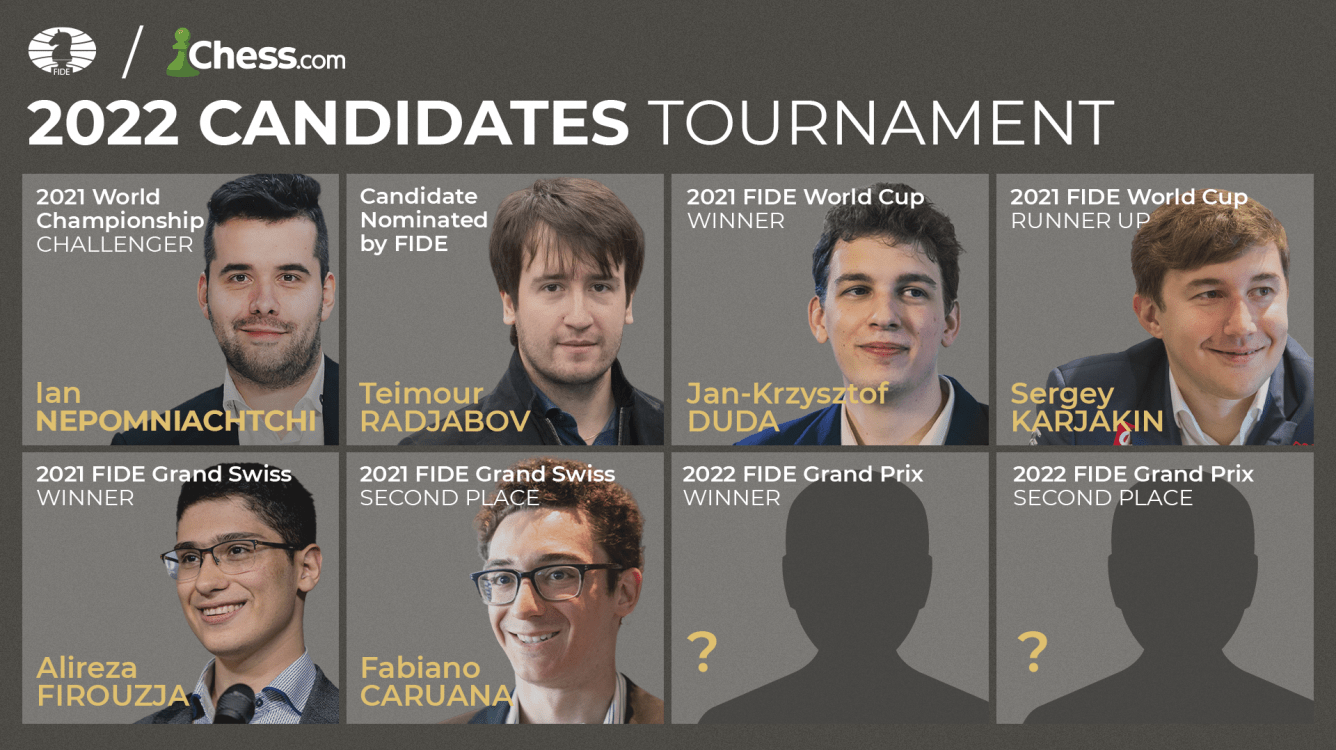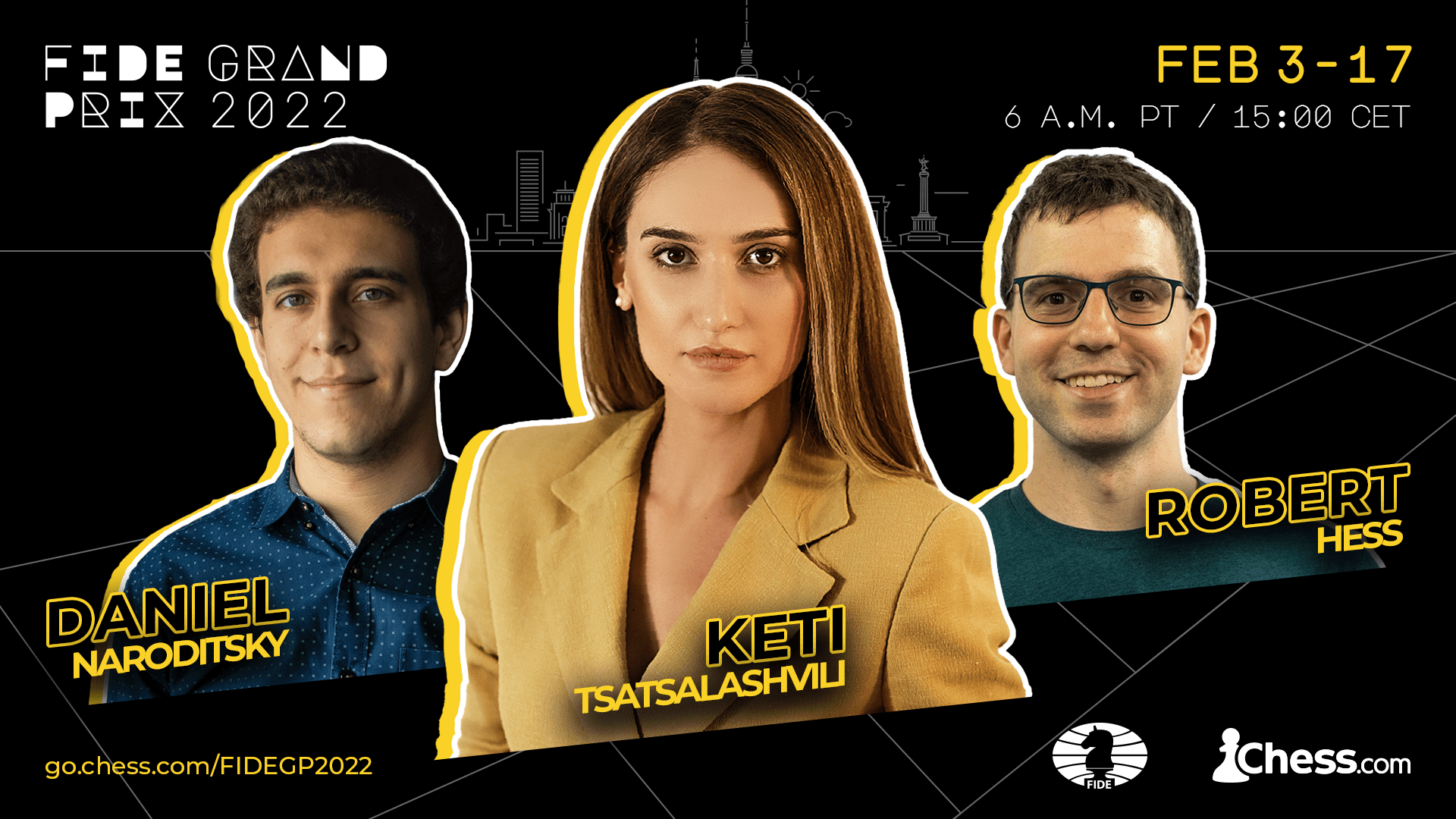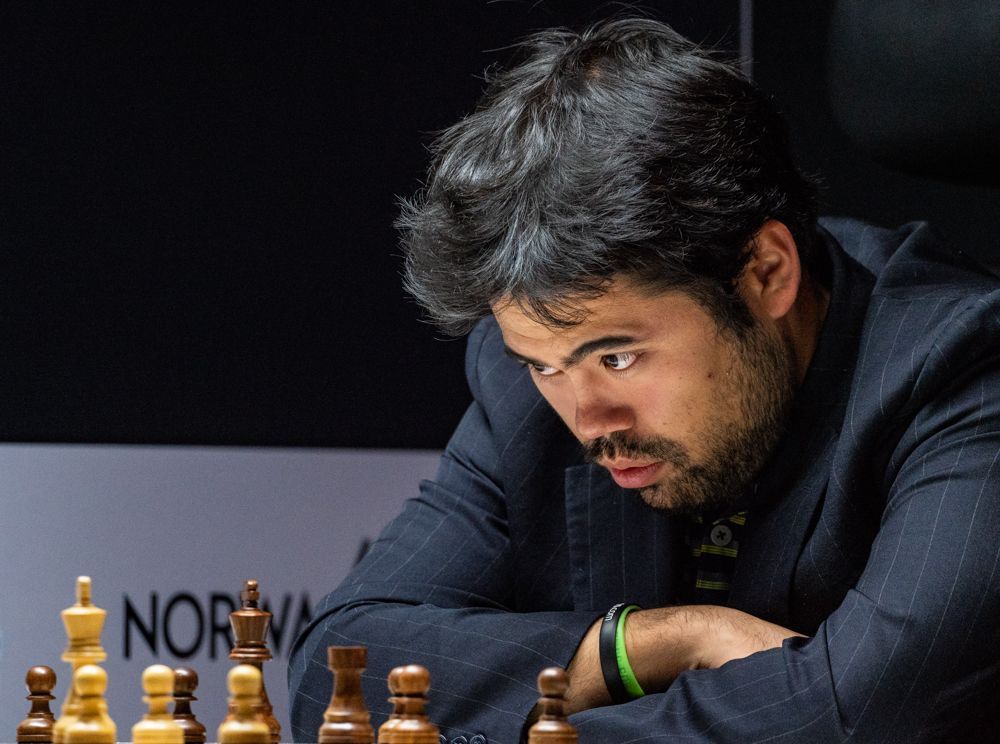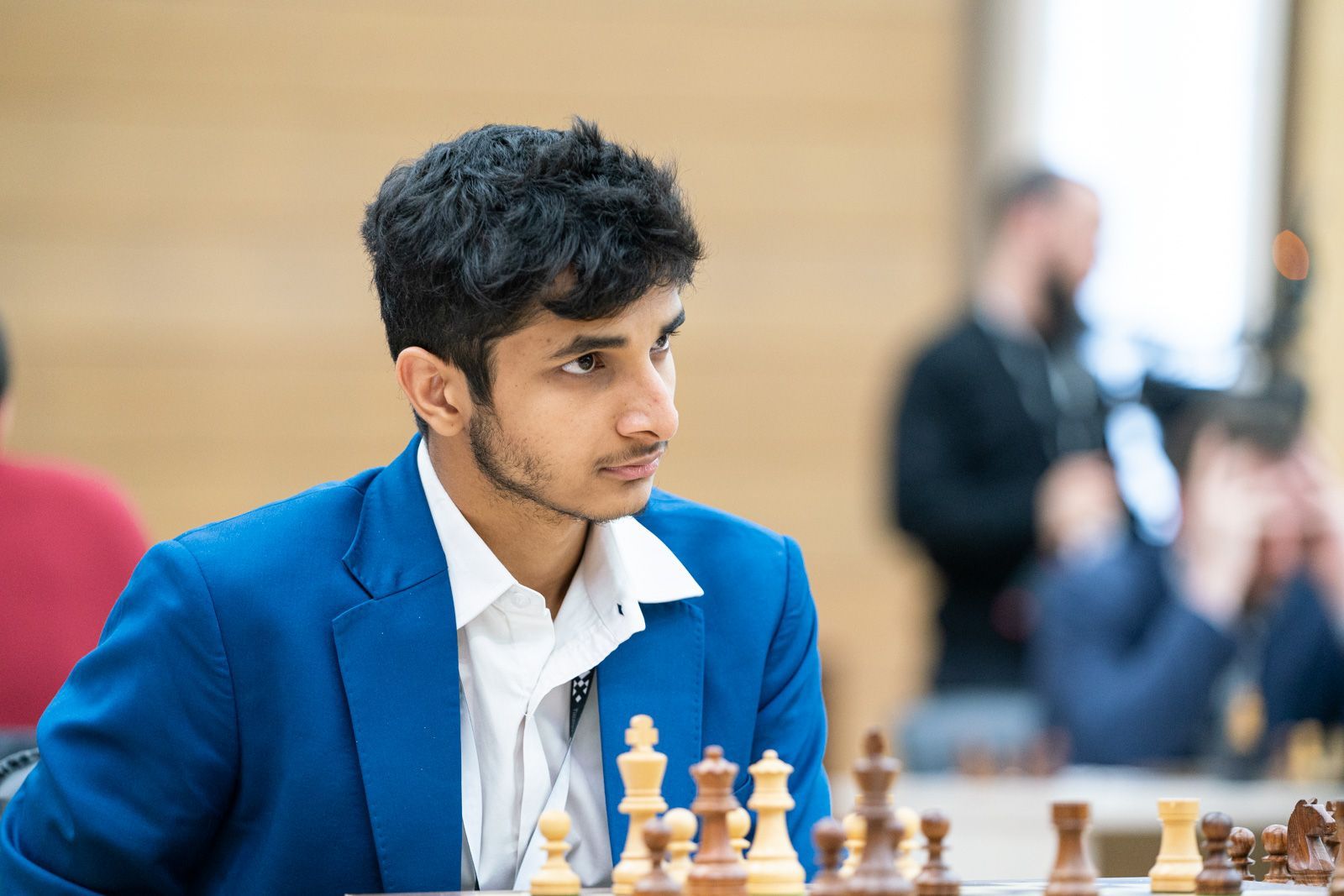
Who Will Grab The Last Two Candidates Spots In The FIDE Grand Prix?
The first Grand Prix was held in 1807, and it was a horserace. Literally. The first chess Grand Prix was not until two centuries later in 2008. The 2022 FIDE Grand Prix begins shortly and it will determine the last two players for June's Candidates Tournament in Madrid.

Below we've briefly outlined possible reasons each of the player at the Grand Prix could reach the Candidates, or otherwise do well in the tournament, where they would join GMs Ian Nepomniachtchi, Teimour Radjabov, Jan-Krzysztof Duda, Sergey Karjakin, Alireza Firouzja, and Fabiano Caruana for the right to face GM Magnus Carlsen for the world championship.
As we wait with bated breath to find out who those last two candidates for the world championship will be, spend some of your time joining our fantasy contest! The players here are divided by tier in the contest, in which you will have the chance to pick one player each from groups based on their ratings when the field was announced. More details in the announcement.
Tier 1
Ding Liren
GM Ding Liren is the highest-rated player in the field by 27 points over the next-closest players and has already been a candidate twice. The Grand Prix will only be Ding's second over-the-board event since the second half of the 2020/21 Candidates; the first was a training match in November 2021 where he scored 3/4 (+2 =2), and he also very nearly upset fellow Grand Prix participant and noted speed demon GM Hikaru Nakamura in the 2021 Chess.com Speed Chess Championship. In addition to his rating advantage over the field, Ding has shown himself to be in form despite limited over-the-board games.
(Unfortunately Ding had to withdraw from the first leg of the Grand Prix due to visa issues.)

Levon Aronian
GM Levon Aronian is a five-time candidate, the most of anyone in the Grand Prix field, and from 2011-18 he did not miss a single Candidates. He now represents the United States and is coming off a strong showing at the 2021 Blitz Championship as well as being one of the top-rated players in the field. Most of his 2021 games came in the Meltwater tournament series where he finished third including one tournament victory, ahead of anyone else who is also playing the Grand Prix.
Anish Giri
GM Anish Giri has been a candidate twice, in 2016 and 2020, both times on account of his rating (a qualification method that, for the first time under the modern system, does not exist this year). In September 2021, he dominated at the Tolstoy Cup, scoring 8/9 and winning by 2.5 points in a field that included two other Grand Prix players and several other strong opponents. He also had a +2 at Tata Steel Chess 2022 after nearly winning it in 2021, and it's now been over half a decade since he drew every game at the 2016 Candidates, so don't let Giri's reputation for draws dominate what you think of him.
Wesley So

GM Wesley So was a candidate in 2018, which he achieved because of his rating. So remains a top-10 player in the world and has won two consecutive U.S. Championships and three overall (2017, '20, '21). The U.S. Championship, along with the Russian Championship, is always one of the strongest national chess championships there is, so doing well there is a good sign. So also has the calm-cool-collected demeanor that helps any chess player.
Tier 2
Shakhriyar Mamedyarov
GM Shakhriyar Mamedyarov is a three-time candidate, twice qualifying through the Grand Prix, including a 2017 victory in the entire event. That got him into the 2018 Candidates, which he entered as the world #2. Coming off a tie for second at Tata Steel 2022 behind only Carlsen, Mamedyarov has easily already shown the endurance necessary for a Grand Prix.

Alexander Grischuk
GM Alexander Grischuk has been by far the best player in the last two renditions of the Grand Prix. After finishing second in 2017, he won it in 2019. Another top-two finish is clearly possible in 2022. Although the format is different this time, Grischuk, like Mamedyarov, has demonstrated the consistency necessary to win a multi-tournament series.
Richard Rapport
GM Richard Rapport made a leap into the world top 10 in 2021 when he led Norway Chess for much of the tournament, and on the live rating list he made it to #6. In the last 4.5 years, Rapport has gained nearly 100 rating points, from 2675 in July 2017 to 2769 in February 2022 (counting Tata Steel, which finished January 30 yet wasn't included in the official list). He made it back into the world top 10 after tying Mamedyarov for second place at Tata Steel, and success at the Grand Prix would continue Rapport's upward trajectory.
Maxime Vachier-Lagrave
Before 2020, GM Maxime Vachier-Lagrave (MVL) was probably the best player in the world who had never been a candidate. He broke that in 2020, after World Cup qualifier Radjabov notably withdrew, but many would argue MVL deserved to have been the wild card that year already. Regardless, MVL finished third in the 2019 Grand Prix, won the 2021 Sinquefield Cup, finished sixth in the 108-player 2021 Grand Swiss, and won the 2021 Blitz Championship. MVL is on a roll and will be looking to remind people that he can't be ignored.

Tier 3
Leinier Dominguez
GM Leinier Dominguez doesn't get enough credit as the best player from Cuba since Jose Capablanca. Now representing the United States and a second to Caruana in the 2018 World Chess Championship, Dominguez has won a Grand Prix tournament (not the full series) before, at Thessaloniki 2013. He's had a very successful past six months—tied for second at the Sinquefield Cup in August, won a Chess960 tournament in September 2021, and was one of only two undefeated players at the 2021 U.S. Chess Championship—and will be looking to build on those performances.
Hikaru Nakamura

GM Hikaru Nakamura became a candidate in 2016 by placing second in the previous year's Grand Prix. He's a five-time U.S. Chess Champion (2005, '09, '12, '15, and most recently in the very strong 2019 field). After warming back up to over-the-board chess at the 2021 Rapid & Blitz, the streaming superstar will be bringing his tenacious, calculating style that made him the nominee of FIDE's president to the Grand Prix.
Nikita Vitiugov
GM Nikita Vitiugov is the reigning Russian Chess Champion, winning games against two fellow Grand Prix players in the process of claiming the title in October 2021. Like Wesley So in the United States, the Russian national championship proves Vitiugov to be a contender in any tournament or series of tournaments.
Pentala Harikrishna
When FIDE announced the setup of the first leg, they also quietly announced that GM Pentala Harikrishna had replaced GM Wei Yi in the field. Harikrishna was for a long time the best young player from India, reaching a rating of 2770 FIDE at his peak. Now 35, he remains a dangerous opponent for anyone.
Vidit Gujrathi
At 27, GM Vidit Gujrathi is currently the highest-rated Indian player besides the legendary but semi-active Vishy. Vidit was a 2021 World Cup quarterfinalist before losing to the eventual champion Duda. Vidit was also the first early leader at Tata Steel Chess 2022. Although he faded somewhat, he showed potency early, and with several players at Tata potentially hiding prep either for the Grand Prix or the Candidates—events that, unlike Tata, have world championship implications—it's hard to say how predictive the January tournament will end up being.

Tier 4
Dmitry Andreikin
GM Dmitry Andreikin reached the Candidates in 2014 from the World Cup. Although he has not been back since, he has remained in the top echelon of players, adding a second Russian Chess Championship victory (they happened in 2012 and '18). After playing very little in 2020, presumably for pandemic reasons, Andreikin spent 2021 rounding back into his form, most recently tying for third in the Russian Championship.
(Unfortunately Andreikin had to withdraw from the first leg of the Grand Prix due to a positive coronavirus test.)

Daniil Dubov
GM Daniil Dubov has a unique, attacking style of play that can win on any day, which is one reason he was selected as the organizer's nominee for the Grand Prix (also presumably a reason Magnus picked him as a second for the past two world championship matches), and like most super grandmasters he's capable of hanging for a draw with anyone as well. The combination makes him a threat in any tournament.
Yu Yangyi
GM Yu Yangyi finished fourth in the 2021 Grand Swiss and before that was also 2021 Chinese Chess Champion in May, his third (2014, '20). While several players qualified for the Grand Prix through the Grand Swiss on a 7/11 score, Yu played the toughest opponents and finished fourth on the tiebreaks. How much better can he do in a non-Swiss format where opposition is often more balanced?
Sam Shankland
GM Sam Shankland reached the World Cup quarterfinals where he pushed eventual runner-up Karjakin to the limit, winning both the first classical game and the first rapid game. Shankland is best known for his deep opening theory, yet even without that advantage at the Chess960 tournament in September 2021 (that Dominguez won), he tied for second with two of his other opponents in the Grand Prix and ahead of two more. Unlike some of the 2022 Tata Steel field, Shankland also gets to rest before his Grand Prix starts, as he is playing the second and third legs.
Alexei Shirov

GM Alexei Shirov underwent a massive resurgence in 2021, rejoining the 2700 rating club at age 49. His eighth-place finish in the 2021 Grand Swiss just bought him a spot in the Grand Prix and he'll be looking to continue his big comeback into the rank of super GMs.
Vladimir Fedoseev
There are several 2021 World Cup quarterfinalists at the Grand Prix, but GM Vladimir Fedoseev is the only semifinalist in the 2022 Grand Prix, before he was stopped by Karjakin. Fedoseev has finished third in the tough Russian Championship two straight years. At last December's Rapid & Blitz, he finished 14th in the Rapid and 9th in the Blitz, making him one of four Grand Prix participants (along with Aronian, Mamedyarov, and Grischuk) to make top-15 in both.
Tier 5
Alexandr Predke
GM Alexandr Predke qualified with a seventh-place finish at the 2021 Grand Swiss, where he was one of the players to win more games (5) than anyone besides Firouzja (6).
Grigoriy Oparin
GM Grigoriy Oparin darn-near qualified directly for the Candidates, tying Caruana at the Grand Swiss on +4 but finishing in third place on tiebreaks.
Vincent Keymer
GM Vincent Keymer, the youngest player in the Grand Prix, finished fifth in the Grand Swiss and will also have "home board" advantage as the only German player in the field.

Amin Tabatabaei
GM Amin Tabatabaei was a World Cup qualifier, reaching the quarterfinals before a loss to Fedoseev. Only 20, Tabatabaei is one of the younger players at the Grand Prix and showed only some of his potential at the World Cup.
Etienne Bacrot
GM Etienne Bacrot, now 38, was the youngest grandmaster in history for a time, and he also reached the quarterfinals of the World Cup, where it took Carlsen to take him out—and there's no Magnus in his way this time.
Replacements
These players were not in the initial field but served as replacements for other players who could not make an event.
Andrey Esipenko
Esipenko, who some felt should have been in the initial field, ultimately replaced Andreikin in the first leg. Esipekno is the #2 junior player in the world after Firouzja and brings excitement to any tournament.
Radoslaw Wojtaszek
Wojtaszek, the #2 player in Poland after Duda and at one time rated 2750, replaced Ding in the first leg. Wojtaszek won Biel 2020 in a field that included two Grand Prix opponents.
Conclusion
Hopefully, you know a little more about the 24 hopefuls at the Grand Prix and their chances in the tournament. Are you ready for two months of dramatic and important chess?
Remember to make your picks in the fantasy contest and watch the Grand Prix, with games beginning February 4!






